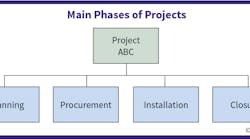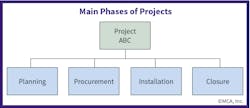In the information age, contractors can no longer operate by relying on subjective, reaction-based decision-making. To guide a project, manage risks, and make decisions effectively as a project team, data-driven methods must be a part of a contractor’s process of project management (Fig. 1). Successful projects result from applying project control throughout all four phases of a project: planning, procurement, installation, and closure (Fig. 2).
The pitfalls of project closure
Of the four phases of a project, project closure is often the most neglected phase. This stems from a number of reasons:
- Perception of lower risks – Once most of the installation is complete — and a fair share of fires have been extinguished along the way — it can be easy to take your focus off a project as the pace slows down. However, the last 10% of the project, when left unchecked, often experiences the highest cost overruns.
- Shifting your focus to other projects – As one project nears completion, key field personnel and project managers move on to the next.
- Reassigned personnel – When the resources who have been most involved with a project are transitioned elsewhere, work to close out the project can fall through the cracks.
- Lack of process – Despite the need to transition labor to other projects, many contractors may lack a process or even a simple checklist to follow, which creates an additional bottleneck for transitioning to future work. Much like the planning that goes into a project at start-up, an equal amount of effort needs to be in place during closeout.
Considerations for project closure
Closeout processes are important in any project-based organization, as they will not only reduce the chances of cost overrun but will allow also for learning and growth throughout the entire organization. To adopt an effective process for project closure, contractors should consider these factors:
- Functional areas and milestones
- Planning for closure
- When closeout should happen
- Customer satisfaction feedback
- Capturing lessons learned
- Personnel reassignment and transfer of ongoing activities
Closure in the contractor environment is a combination of both on-site management and administrative functions from both the field and the back office, involving the following functional areas:
- Accounting
- Field
- Customer service
- Purchasing
This phase encompasses the end of the project life cycle, or the least favorite step of the building process. More importantly, this is the milestone that signals the transition of project risk from the contractor to the owner. Regardless of whether the project is sufficiently complete and operational in accordance with the contract (i.e., substantial completion), granted certificate of occupancy, or final completion, the project doesn’t end until final payment has been received. At that point, the accounting team can move the job from the work in process to closed status.
Planning for closure
Planning for closeout should begin with Step 1 in the planning phase at the start of the job. During the planning phase, the team should:
- Identify key milestones for deliverables tied to the contract and billing.
- Identify requirements for the release of retainage.
- Identify and rank the likelihood of risks at ramp down, such as last-minute change orders, demobilization, damage claims, and warranty work that they may be responsible for.
- Identify what documentation will be required by the owner, such as O&M procedures and practices, change-orders, cut sheets, punch lists, warranties, and the timing of them.
- Ensure a corporate governance structure is in place for document storage with expectations established of what is required for follow-through from the project team throughout the project life cycle.
- Plan what will happen with manpower, material returns, and demobilization.
- Identify requirements for substantial completion, certificate of occupancy, final completion, and ultimately final payment.
A work breakdown structure is the recommended tool for capturing and planning all phases of the work and can be useful in the closure phase of the project to identify and plan for both standard and job-specific activities required. Figure 3 shows an example of a project closure work breakdown structure completed on a sign project.
When to closeout
Traditionally, contractors may assume the closeout process should begin at substantial completion; however, in doing this, project teams will often deal with unnecessary stress in trying to close out one project while being pulled into the next. This can also lead to projects lingering at a slow pace, increased costs, and delayed payment. The longer a project team postpones identifying the objectives and tracking the deliverables needed to complete the closeout process, the worse these impacts may be.
Once the initial scope of the project has been conducted, personnel transition between the project team may take place. In construction, this might mean something as simple as introducing the service manager to the owner’s representatives once the job is at 75% complete or bringing in service techs to help finish punch lists. To execute this step, put a plan in place to help build the long-term relationships that are instrumental in developing the service and maintenance work that follows any project. Or do you want the deliverable handoff to be the last contact you have with the owner?
Capturing lessons learned
Lessons learned is a critical element to project closeout. Because of the uniqueness and complexity of construction projects, individuals on one project may come away from a project with an entirely separate set of experiences and knowledge than another. It is up to the organization’s leaders to ensure that a data-driven process for capturing these learnings is in place. Without this, an organization will have limited growth and repeat mistakes.
Job-site intelligence and data from the field can streamline the process and avoid delays due to missing documentation and additional follow-up before the final handoff. At this point, the project team should conduct “lessons learned” of not only what went well, but also what did not go well — and how things could be improved during each phase of the project life cycle.
Dr. Perry Daneshgari is president and CEO of MCA, Inc., Grand Blanc, Mich. He can be reached at [email protected].
Sydney Parvin is associate data analyst and technical assistant to the VP of Operations at MCA, Inc., Grand Blanc, Mich. She can be reached at [email protected].






